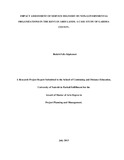| dc.contributor.author | Rotich, Felix K | |
| dc.date.accessioned | 2013-09-16T12:39:03Z | |
| dc.date.available | 2013-09-16T12:39:03Z | |
| dc.date.issued | 2013 | |
| dc.identifier.citation | Master of Arts Degree in Project Planning and Management | en |
| dc.identifier.uri | http://erepository.uonbi.ac.ke:8080/xmlui/handle/123456789/56592 | |
| dc.description | A Research Project Report Submitted to the School of Continuing and Distance Education, University of Nairobi in Partial Fulfillment for the Award of Master of Arts Degree in Project Planning and Management | en |
| dc.description.abstract | The purpose of this study was to explore and adopt best approaches in implementing both emergency and development programs in the Arid Lands of Kenya by Non-Governmental Organizations; with due consideration to the several hindrance to their performance. The study also aimed at ascertaining the impact of these NGOs on the livelihoods of the people from the host communities; establish factors contributing to poor service delivery and to develop effective development approaches which are contemporary and compatible to the same communities. The three objectives and the three research questions formulated formed the basis for this research study. The research was a case study of Garissa County in North Eastern Province which comprises of six districts namely: Garissa, Balambala, Ijara, Fafi, Lagdera and Dadaab districts with an estimated area of 45,720.2km2 and a population of 623,060 people based on the 1999 national census. Target Population comprised of both direct and indirect beneficiaries; women and men, boys and girls. Out of the estimated target population of two thousand beneficiaries, a sample size of four hundred people was randomly chosen and questionnaires administered to them. Data from the field was analyzed using SPSS and the results presented in form of tables and standard reports. The study found out that poor roads and insecurity in Garissa County were the two main factors affecting delivery of service by NGOs. However, the Government of Kenya has been sensitive on the matter and is keen in putting measures in place to fix the anomaly. The study also found that host communities were not empowered and/or involved in most of the stages of project cycle and that most of the projects were donor initiated; an approach that has led to project failures in the past. This study therefore recommends the need to improve road network and boost security in Garissa County for better service delivery in future. It also recommends for empowerment of the host communities through involvement in most stages of project cycle in order to enhance sustainability of projects. | en |
| dc.language.iso | en | en |
| dc.publisher | University of Nairobi | en |
| dc.title | Impact Assessment of Service Delivery by Non-governmental Organizations in the Kenyan Arid Lands. A Case Study of Garissa County | en |
| dc.type | Thesis | en |
| local.publisher | School of Continuing and Distance Education | en |

